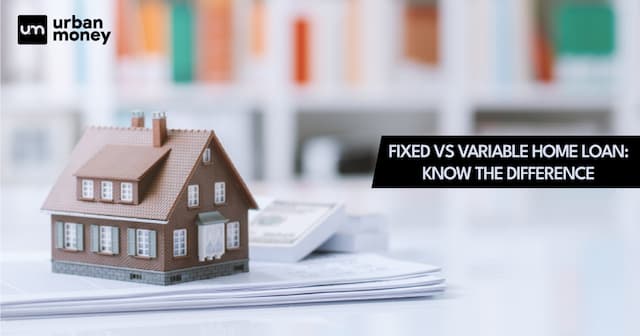Types of Home Loans in Australia

Choosing a home loan may be as stressful as locating the ideal property in Australia, although there are now many options and mortgage companies to select from. But it's not easy for everyone to find the exact option for which they are searching. So, to remove this problem, we decided to smooth your journey by providing a list of Australia's top house loans, as determined by Urban Money’s Home Loan Experts.
The ideal loan for your home purchase will depend on your particular situation. Australian borrowers have access to various home loan packages offered by hundreds of loan experts, but not all of them may be the ideal choice for their specific needs. It is necessary to do your homework, get to know your options, and know what features will work best for you.
But you need not worry. Our analysts have already done research to assist you in choosing a better home loan.
The existence of Australia is intensely impacted by homeownership. Owning a piece of property isn't just about having a rooftop over your head; it's monetary security and a wellspring of pride. However, before you set out on this astonishing excursion, it's important to know the fundamental sorts of home loans that you can get in Australia.
The main types of home loans
Let's compare the benefits and drawbacks of the various home loan options.
There are several different types of home loans to choose from, like a line of credit (an equity loan), a fixed interest rate loan, and a variable interest rate loan (standard and basic). Some of the main types of home loans are mentioned below.
Bridging Loans
Bridging home loans are a sort of short-term loan that empowers you to buy a property before you have sold your ongoing one. In Australia, crossing-over credits are generally accessible for a limit of a half year.
At the point when you take out a bridging loan, the lender usually takes over the documents of your existing property as well as financing the purchase of the new property as security for the borrowed loan. The total amount borrowed is called the peak debt, and it also includes the balance of the loan on your existing home.
The minimum repayments on a bridging loan are often estimated on an interest-only basis, and in many cases, this interest gets capitalised until the existing home is sold. This is also added to the peak debt.
- It's good for people who need money right away to buy a house and can't wait for their current home to sell.
- It saves you money by allowing you to move into your new home without paying rent.
- Interest-offset features are provided by some lenders.
This loan is best for those who require money quickly and do not want to miss out on any opportunity to purchase a particular home while waiting for the sale of their present property to take place.
Remember to review your options carefully before taking out a bridging loan because they are more expensive than traditional loans. If your house takes longer to sell or sells for less than expected, you may face financial issues.
Construction Home loans
Construction loans, commonly referred to as owner-builder loans, differ from traditional home loans in that they require recurring payments while the construction grows. A traditional home loan makes the entire loan amount available in a single lump sum, whereas a construction loan allows borrowers to draw on the loan balance when payments are due to the builder. These payments, known as progress payments, are made at key stages of the construction process.
While work is still underway, you might be approached to make a repayment of the amount that has been drawn down. Because of this, you won't have to pay interest on money that has already been used. As a result, your loan's initial repayments will be lower, but they will gradually rise as your construction project nears completion.
- During construction, loans may be interest-only, which means that until the time of construction, you only need to pay interest on the borrowed amount.
- Loan terms are flexible and can be renegotiated.
- The drawdown feature allows you to keep track of your spending.
A construction home loan is designed for someone who wants to build a new house or make significant modifications to an existing property but is not interested in purchasing it.
Be prepared to offer a large amount of documentation, such as building designs and a timeline, forms from an authorised contractor, and so on.
Variable-rate home loan
A usual variable rate home loan is known for its continually changing interest rates by the Australian Reserve Bank's official cash rate. This means that the borrower may have lower regular repayments when interest rates drop and larger regular repayments when interest rates rise. In Australia, nearly all home loans are ordinary variable-rate loans.
- It may be beneficial in times when interest rates are low.
- The account of a variable home loan includes redraw and offset features that you will not get with fixed-rate mortgages.
- You can make unlimited payments to pay off your mortgage early without any penalties.
For first-time home buyers and anyone looking to get more features in their loan to pay off, this is one of the best types of loan you can go for.
Fixed-rate home loans
A fixed-rate mortgage is one in which the interest rate is fixed, or locked in, for a particular period at the start of the mortgage. For a maximum of 5 years in Australia, you can lock in or fix the interest rate before the loan reverts to a variable-rate loan.
- You can save some money by locking in interest rates lower than a standard interest rate.
- Certainty in knowing exactly what you need to repay for a specific fixed period
- You can budget without thinking about interest rate hikes.
A fixed-rate home loan is ideal for those who need consistency in their weekly or monthly repayments. Taking out a mortgage with a fixed interest rate may give you some peace of mind, but keep in mind that you will not get any benefit from rate decreases because your repayments are bound to the fixed rate you signed up for.
Interest-only home loan
Most home loans are principal and interest loans, which means that making regular payments will reduce the principal amount you borrowed as well as help with the repayment of your loan's interest. With this type of loan for a specific period, you only need to pay interest on your loans. This feature of paying only interest is only available for the first five years.
- Repayments stay lower for a principal and interest loan.
- Due to lower repayment, borrowers can invest their money somewhere else for better returns.
- Investors can gain tax benefits from the interest payments being offset against rental income.
Interest-only mortgages are designed particularly for those who prefer to pay less in mortgage payments during the initial years of their loan so that they can reinvest their funds in a possibly more profitable enterprise.
Before signing up for an interest-only loan, review your situation to ensure that you will be able to handle the extra instalments after your interest-only period ends.
Introductory Home Loan
In introductory loans, lenders offer home loans with a particularly low-interest rate for a short period at the beginning of the loan term to attract potential borrowers. This rate, sometimes known as the honeymoon rate, generally lasts only for around 12 months before it rises and reverts to standard variable rates.
- The introductory interest rate should be among the lowest in the market.
- First-time buyers can use the saved money to increase their principal repayments.
- In introductory home loans, several lenders provide redraw and offset alternatives.
Anyone who wishes to save money by getting a cheaper home loan interest rate, even if only for a year, can go with an introductory loan. When the honeymoon period expires, you may be locked into a higher interest rate than other loans on the market at the time.
Learn more: Home Loan Guides?
Line of Credit Home Loan
This form of home loan is based on the equity in your property, and you can get funds when needed. These loans are innovative ways to raise capital for investment by delivering cash up to a predetermined limit. The loan account balance is reduced each month by the amount of cash received and increased by the amount paid on the credit card or withdrawn in cash.
These accounts can perform well as long as there are constant flows of money in and out. However, it can be expensive if the line of credit balance is not lowered regularly.
- It enables access to funds for a variety of purposes, including vacations, renovations, a new vehicle, and medical emergencies.
- It allows you to repay the credit extension in either interest-only or head-and-interest portions.
- The credit extension process is normally direct, requiring fewer papers than getting another loan.
It is one of the best types of loans for those who can use the equity in their property for cash withdrawals.
There is a high risk of losing equity in your home with these types of loans if you can’t meet repayments.
Low Documents Loan
A low-doc or no-doc mortgage is suitable for investors or self-employed borrowers who want to refinance, purchase, or renovate their home.
On this type of loan, lenders offer a high-interest rate because the borrower's income cannot be confirmed through normal means. As a result, a low-doc loan typically has a higher-than-average interest rate, as well as greater restrictions on the maximum loan-to-value ratio (LVR), available loan features, and package discounts.
- It gives those who don’t have standard loan documentation a chance to enter the property market.
- There is a possibility of a mortgage refinance after an agreed-upon period.
- Some low-document loans offer redraw and offset facilities.
You need to pay a higher financing cost for this sort of credit and have less of an open door to search for the best arrangement because few banks or moneylenders offer low-doc credits.
Non-Conforming home loan
Individuals with low FICO ratings or who have financial needs that are somewhat strange can frequently experience difficulty obtaining home credit. "Non-conforming loans" are mainly offered by lenders to people in these kinds of situations.
While banks will neglect earlier credit issues, they need proof of your capacity to reimburse loan advances. A larger deposit is also typically required for these kinds of loans.
- These types of loans also give borrowers with poor credit histories the chance to enter the property market.
- Provides an opportunity for refinancing after an agreed-upon period.
- A non-conforming home loan offers some of the benefits of standard variable loans, such as redraw and offset facilities.
Split-Rate Loans
A split-rate loan consists of both fixed-rate and variable-rate features for a particular period. As the borrower, you can usually decide what percentage of your mortgage you wish to allocate to rates.
- In this loan, you get insurance against interest rate rises because the fixed portion of the loan is unaffected.
- In this loan, you can make extra repayments on the variable portion of the loan.
- With the borrowing of this loan, you will also get some benefits, such as redraw and offset facilities, in the variable part of the loan.
While taking these types of loans, you need to be aware of their good and bad features, like the fact that a part of your loan is protected from rate hikes. But if rates drop, only a portion of your loan can take advantage of the lower costs.
Eligibility Criteria to Get a Home Loan
In Australia, the eligibility criteria for getting a home loan may vary depending on lenders, but there are some basic similar requirements that most financial institutions consider while evaluating applications.
Age and Residency Status
You need to be at least 18 years old to apply for any home loan.
You must be an Australian citizen or a permanent resident with a valid residential status to apply for it.
Income and Employment
In some cases, lenders may ask to assess your income to ensure your ability to repay the loan. You may need to provide payslips, tax returns, or other necessary documents.
Some lenders may need a minimum income requirement, and they generally prefer borrowers with stable employment histories.
Creditworthiness
Lenders may check your credit score or credit report to evaluate your financial conditions,
A good credit score generally improves your chance of loan approval.
Financial Stability
Before lending a loan, lenders may examine your financial stability and credit history, including your existing debt and assets.
They can calculate your debt-to-income ratio to determine your comfortability in managing your payments.
Deposit
Borrowers typically need a deposit to get a home loan in Australia. While the amount may vary from lender to lender, it is commonly required to deposit at least 20% amount of the loan Property.
Property Type
Some lenders may have restrictions or higher requirements for certain property types like investment properties or vacant land.
Loan Purpose
The lender may inquire about the purpose of the loan. Most home loans are only available for owner-occupied properties, under which investors are not eligible for the loan.
Documentation
You need to provide various documents, including proof of identity, bank statements, tax returns, and other related documents.
Required Documents for Taking Home Loan
These are some mandatory documents required while taking a loan in Australia.
Proof of Identity
- Passport or driving license.
- Birth Certificate
- Medical card, if any
Proof of Income
- Tax returns and group certificates.
- Letter of Employment.
- Bank statements and ABN (Australian Business No) registration no.
Financial Statements
- Statements of the existing loans, if any, including both personal and credit cards.
- Bank statements for all your accounts, including savings and current accounts.
- Statements of assets you own.
Property Information
Details of the property you plan to purchase, including its price and location.
Liabilities
Details of any outstanding debts, such as car loans, personal loans, or credit card balances.
Proof of Expenses
You need to provide information on your regular living expenses, which may include rent and other commitments.
Credit History
Lenders sometimes can check your credit history issued by credit reporting agencies like Equifax and Illion.
Other Documents
In some cases, lenders may ask for other documents depending on your specific circumstances.
Frequently Asked Questions
What is the most common type of home loan?
The most widely recognised kinds of home loans in Australia is variable-rate loan and fixed-rate loan.
Which one is better, fixed or variable?
While both loans have their merits, some borrowers opt for a split loan, which gives them access to a portion of each type’s advantages.
How many mortgages are there in Australia?
In Australia, there were millions of active mortgages.
What is a standard loan?
A “standard loan” generally refers to a traditional home loan, which is the most well-known option for a home loan in Australia.
What is the highest mortgage rate in Australia?
Mortgage rates in Australia can change over time and across banks, and the most elevated mortgage rate out of nowhere depends upon common economic situations.
Related Posts

Nov 03, 2023
Top 10 Best Home Loans in Australia 2023












